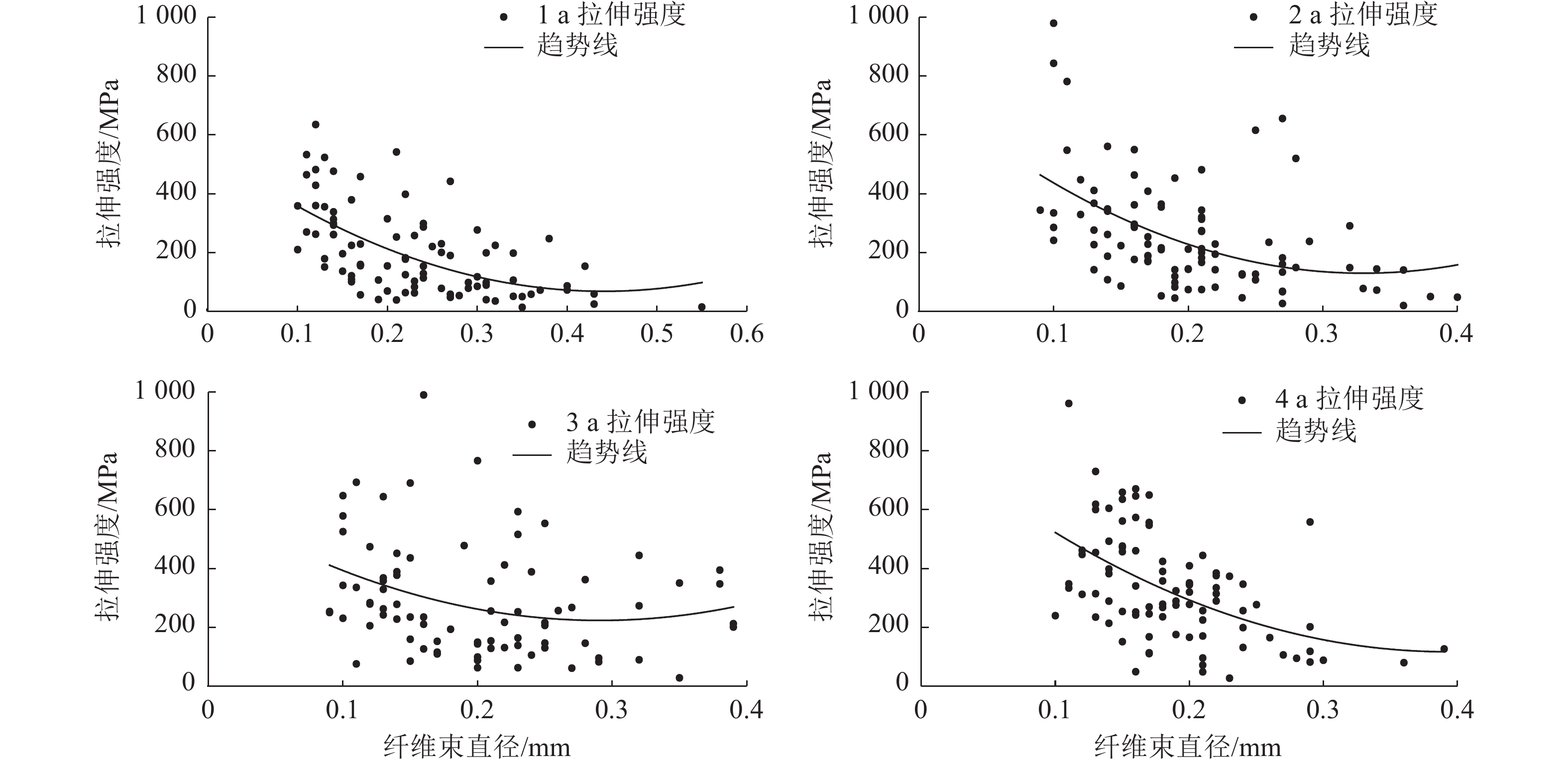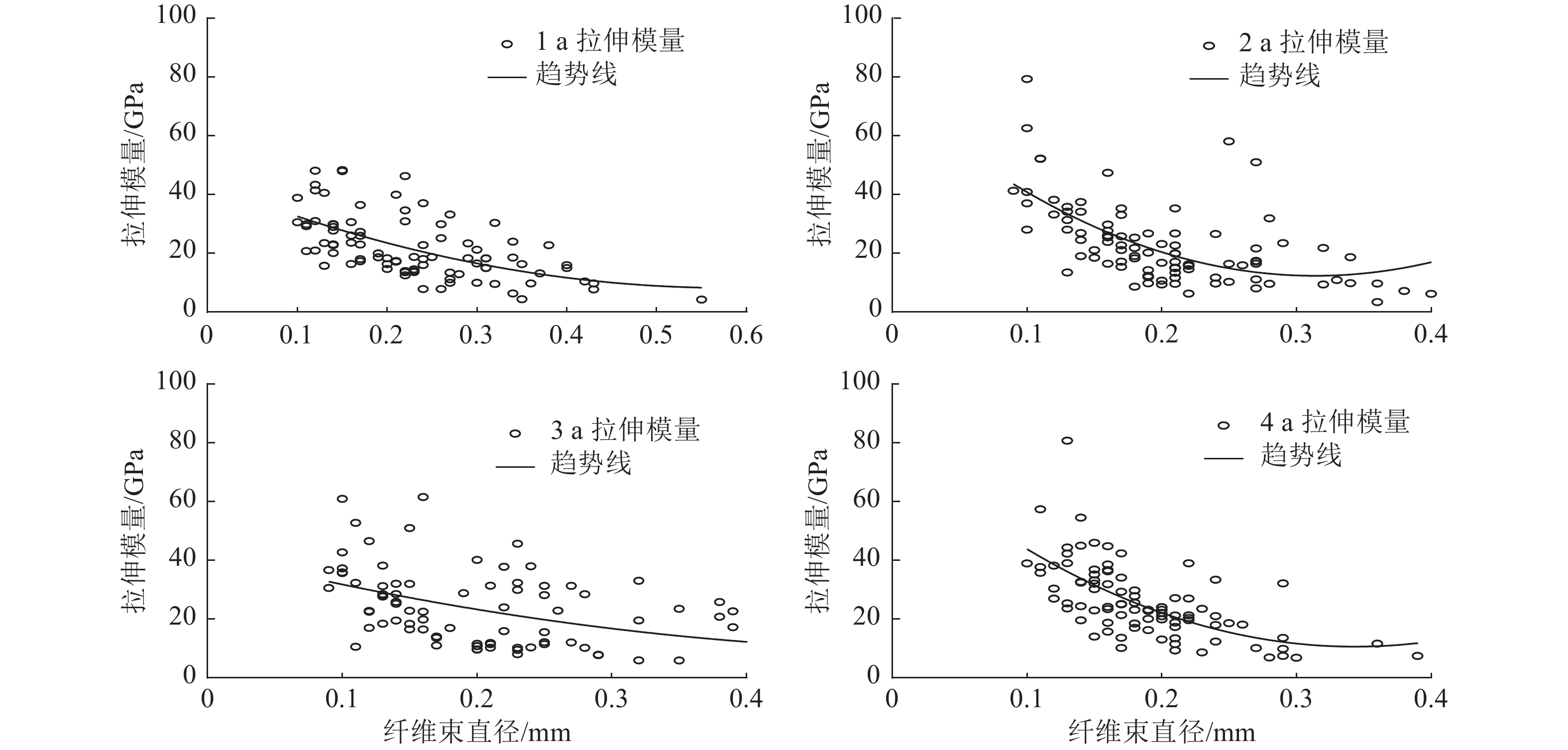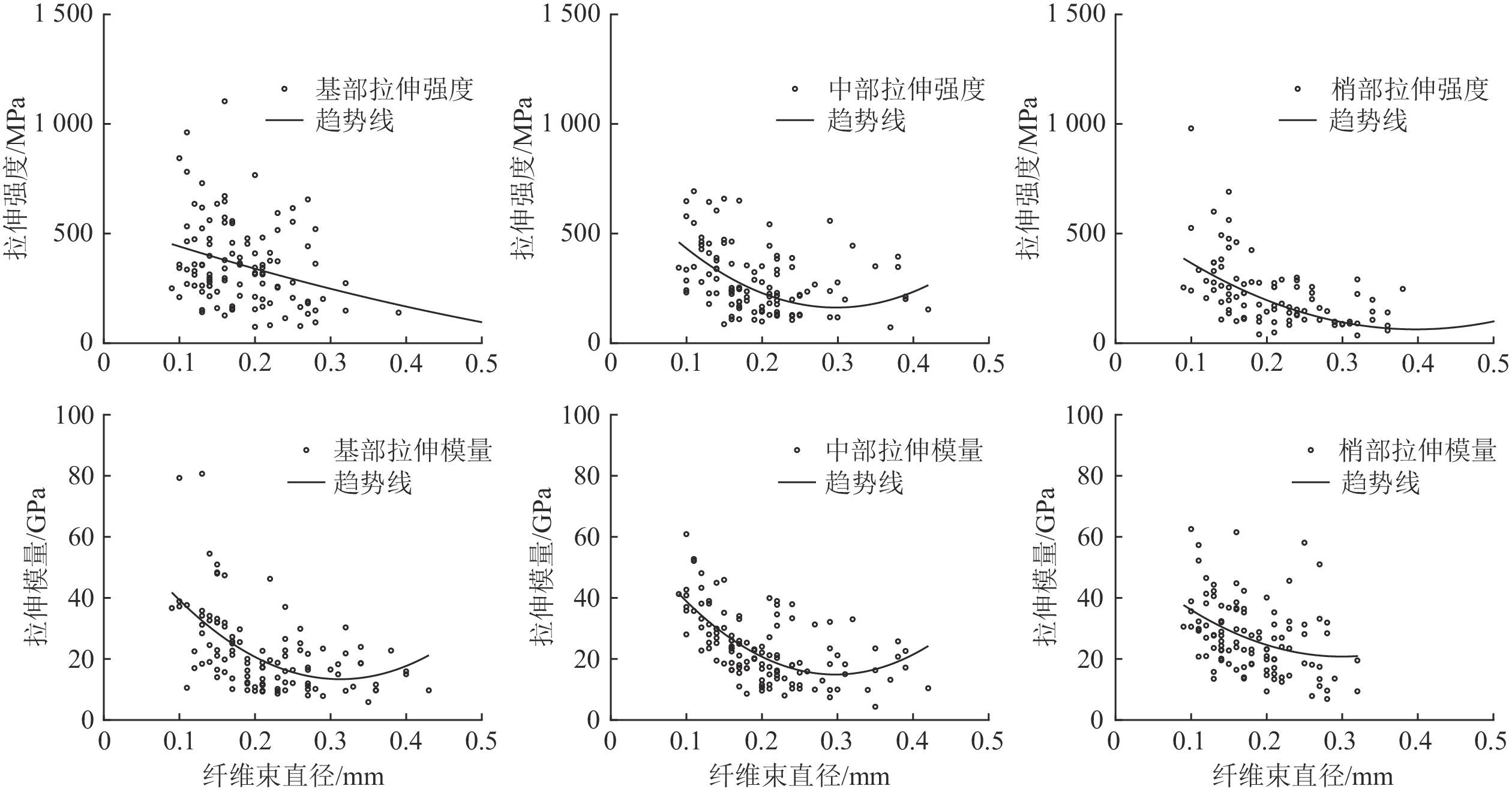-
竹材绿色、低碳、速生、可再生、可降解,是优良的生物质材料,竹材砍伐后加工成竹制品可起到碳转移、缓冲碳排放等作用。在全球可持续发展背景下,竹材的开发利用受到广泛关注,可替代木材、塑料、钢材、人造纤维等[1−2]。中国竹林面积较大,但在竹类划分中,仅分为毛竹Phyllostachys edulis和杂竹。这种划分不能满足竹产品对竹资源以及竹种差异性的需求[3],且很多国家的竹资源开发仅限于简单利用或初级加工利用,大量竹资源尤其是丛生竹资源的应用价值未得到充分挖掘[4]。
簕竹Bambusa blumeana也称箣竹,隶属禾本科Poaceae竹亚科Bambusoideae簕竹属Bambusa,地下茎合轴丛生,茎秆下部枝条繁茂多刺,原产于印度尼西亚和马来西亚东部,在菲律宾、泰国、越南均有栽培,中国福建、台湾、广西、云南、海南等省也有栽培[5−6]。簕竹秆型高大、秆径中等、节间较长,属秆型优良的大型高产丛生竹种,具有较高的经济利用价值[7],目前已被应用于家具、观赏园艺、手工艺品制作、住房建设等,但精深加工利用较少[8−9]。竹材理化性能、力学性质等材性数据是竹材开发利用的基础,决定了竹材的应用范畴。王鹏程等[10]对梁山慈竹Dendrocalamus farinosus不同径向位置的纤维形态研究发现:竹龄为3 a的梁山慈竹纤维形态较优。姚开泰等[11]对不同竹龄和纵向部位的青皮竹B. textilis物理力学性能研究发现:随竹龄增大,青皮竹的密度逐渐增大,竹龄为4 a的青皮竹全干密度和纤维束拉伸强度最高,随着竹秆纵向部位升高,纤维趋于细短,纤维束拉伸性能下降。朱宗伟等[12]研究表明:对于麻竹D. latiflorus的综纤维素,冷水、热水和质量分数为1%的氢氧化钠(NaOH)抽出物质量分数随竹龄的增长逐渐减小;苯醇抽提物质量分数随竹龄的增长变化不大。牛思杰等[13]研究发现:竹龄可作为筛选原材料的优先指标。综上所述,竹龄和部位对竹材理化性质有较大影响。鉴于此,本研究探究竹龄及纵向部位对簕竹竹材气干密度、全干密度、纤维形态、化学组分、抗弯性能、顺纹抗剪强度、纤维束拉伸性能的影响及变化规律,以期为簕竹的工业化利用提供理论依据。
-
簕竹采自云南省临沧市沧源瓦族自治县(23°21′N,99°27′E)。在同一片竹林中,分散选取有代表性、无明显缺陷、竹龄为1、2、3、4 a的簕竹,各竹龄采集8~10株。簕竹的胸径、节高以及壁厚如表1所示。截取离地面高度分别在1~3 m (基部)、3~5 m (中部)、5~7 m (梢部)的竹段样本进行后续研究。
竹龄/a 胸径/cm 节高/cm 壁厚/mm 1 40.2~70.8 23.6~45.6 4.6~10.0 2 33.9~52.2 20.4~36.5 3.5~7.9 3 36.3~63.7 33.3~41.5 4.8~9.9 4 45.2~70.6 30.9~43.8 4.5~12.7 Table 1. Diameter at breast height, node height and wall thickness of B. blumeana of different ages
-
参照严彦等[14]的方法,从不同竹龄、不同纵向部位的簕竹竹筒上截取试样。测试气干密度和全干密度。
-
随机选取不同竹龄、不同纵向部位的簕竹试样,去青并粉碎,过40~60目筛。采用范氏洗涤法测定纤维素、半纤维素和木质素质量分数。参照周鑫等[15]的方法,测定苯醇抽提物质量分数。每组样品测定3个重复,取平均值。
-
将竹条劈成火柴棒大小,浸泡在质量分数为95%的冰乙酸与质量分数为30%的过氧化氢的体积比为1∶1的混合液中,于80 ℃水浴中处理10 h,至试样变白。使用去离子水洗涤试样至中性,将纤维充分打散。在OlmpusBX 51光学显微镜下测定纤维长度和纤维宽度。纤维长度每组测定100根,纤维宽度每组测定50根。
-
调节竹材含水率为12%。抗弯性能、顺纹抗剪强度参考严彦等[14]的方法进行加工测定。
-
将竹片放入到质量分数为5%的NaOH溶液中,60 ℃水浴加热20 h,经温水冲洗数遍至中性,含水率控制在30%~60%,之后用平板硫化压机平压和双锟混炼挤压将竹片松散疏解,使用梳子进一步分丝,获得簕竹纤维束。将纤维束用纤维切断器切断至80 mm长,抽取30根无明显缺陷的纤维束进行测试。为防止测试时纤维束发生滑移,对试样进行一定的处理[16]。参照黄慧等[17]的方法测定纤维束拉伸性能,加载速率为2 mm·min−1,夹持长度为80 mm,标距为60 mm,测定前在光学显微镜下测量纤维束直径。
-
采用SPSS 27对纤维形态进行单因素方差分析(one-way ANOVA),显著性水平为0.01,采用Origin 2022绘图,采用gauss函数对纤维束拉伸强度进行拟合。
-
密度是评估竹材品质和质量的基本指标之一,与竹材力学性能、硬度等密切相关[18]。一般而言,密度越高,则竹材纤维结构更坚硬和紧密,机械性能越好[19]。如图1所示:不同竹龄和竹秆纵向部位的簕竹气干密度、全干密度最大值可达0.723、0.739 g·cm−3,平均气干密度为0.587 g·cm−3,平均全干密度为0.669 g·cm−3,低于毛竹的全干密度(0.700 g·cm−3)和气干密度(0.759 g·cm−3)[20−21]。簕竹的气干密度随着竹龄的增长而呈增大趋势,其中竹龄为1 a的簕竹平均气干密度为0.566 g·cm−3,而竹龄为4 a的簕竹平均气干密度可达0.615 g·cm−3,簕竹的全干密度随竹龄的增长也呈增大趋势。这种变化主要是由于竹材生长的过程中,其细胞壁和内部组成物质在生长过程中不断生成和累积,纤维壁厚也随着竹龄显著增长,导致气干密度及全干密度增加[22],这与毛竹、麻竹的变化趋势一致[23−24]。另外,簕竹竹材的气干密度、全干密度随着竹秆纵向部位的增加呈逐步增加的趋势,基部至梢部气干密度从0.554 g·cm−3增加到0.619 g·cm−3,全干密度从0.590 g·cm−3增加到0.723 g·cm−3。这种变化可能是随着竹秆高度的增加,单位横截面积内维管束分布数量不断增多,维管束分布密度逐渐增大,从而使竹秆梢部密度更高[25]。
-
竹材化学组成的不同可能会引起竹材结构和性能间的差异[26]。如表2所示:簕竹纤维素平均质量分数为41.4%,与慈竹相当[27];半纤维素质量分数为12.2%~17.2%,木质素质量分数为26.6%~32.4%,均值为29.6%,高于慈竹(24.0%)、毛竹(22.4%)。因此,在竹浆造纸方面,可选择竹龄为1和2 a的簕竹。苯醇抽提物平均质量分数为2.6%,低于毛竹(3.6%)[28]。苯醇抽提物是以苯、乙醇混合物进行抽提,可从原料中溶解树脂、脂肪、蜡、色素及可溶性单宁等。簕竹的苯醇抽提物低,表明簕竹的耐虫、抗菌等性能可能优于毛竹和慈竹[29]。随竹龄增加,纤维素质量分数先降低后略微增大,竹龄为1 a的簕竹纤维素质量分数最高,均值达45.3%,竹龄为3 a的簕竹纤维素质量分数最低。半纤维素质量分数随竹龄的增加先减少后增大,但总体变化较小。木质素质量分数随竹龄的增加逐渐增大,这是由于随竹龄增大,竹材木质化加剧所致[30]。苯醇抽提物质量分数随竹龄增大而增加。从基部至稍部,纤维素质量分数逐渐降低,半纤维素质量分数差异不大,木质素质量分数逐渐增大,苯醇抽提物质量分数无明显变化规律。簕竹化学组分随竹秆位置的变化趋势与毛竹相似[31]。
竹龄/a 纵向部位 纤维素质
量分数/%半纤维素质
量分数/%木质素质
量分数/%苯醇抽提物
质量分数/%竹龄/a 纵向部位 纤维素质
量分数/%半纤维素质
量分数/%木质素质
量分数/%苯醇抽提物
质量分数/%1 基部 49.0±0.9 13.9±0.2 24.8±0.6 2.1±0.2 3 基部 40.8±1.3 14.6±0.3 29.4±0.9 2.6±0.8 中部 44.4±0.4 13.2±2.3 28.2±2.1 2.0±0.3 中部 38.3±1.0 14.2±1.4 32.2±2.0 2.7±0.0 梢部 44.2±1.6 14.1±0.4 27.4±1.6 3.3±0.6 梢部 36.2±2.4 15.8±1.2 31.4±2.8 2.6±0.3 2 基部 48.6±1.4 12.2±0.6 26.6±1.7 2.0±0.1 4 基部 41.3±0.6 14.3±0.4 29.6±0.4 3.4±0.5 中部 42.2±0.9 13.2±0.3 29.8±0.5 2.9±0.4 中部 38.8±1.6 14.8±0.3 32.0±1.7 2.8±0.1 梢部 39.0±1.1 14.2±1.4 32.4±1.1 2.7±0.1 梢部 34.1±1.8 17.2±0.5 31.6±0.8 2.6±0.1 说明:数值为平均值±标准差。 Table 2. Chemical fractions of longitudinal part of B. blumeana under different bamboo ages
-
由表3可知:簕竹纤维长度为0.42~5.99 mm,纤维宽度为6.50~38.87 μm。整体纤维形态特征与同属的油簕竹B. lapidea较为接近,属细长、柔性型纤维,是制浆造纸的上等原料,在纤维化利用方面极具开发潜力[32]。不同竹龄之间簕竹纤维长度和宽度有一定差异,竹龄为1 a的簕竹相对较小,竹龄为2和3 a的簕竹趋于稳定,竹龄为 4 a时,簕竹纤维长度和宽度最大,竹龄为1 a的簕竹平均纤维长度为2.01 mm,竹龄为4 a的簕竹平均纤维长度为2.83 mm。簕竹纤维长度纵向变化从大到小依次为中部、梢部、基部,纤维宽度基部到梢部呈逐渐减小的趋势,长宽比梢部最大。显著性分析表明:竹龄为1、2、3 a的簕竹纵向部位的平均纤维宽度差异不显著。竹龄为4 a的簕竹不同纵向部位的平均纤维长度差异极显著(P<0.01),竹龄为1 a的差异不显著。牛思节等[13]研究发现纤维形态受竹龄影响最大,纤维长度随竹龄增大,但在轴向高度上纤维长度未见明显差异。蔡燚等[33]研究认为:毛竹的纤维长宽比在轴向高度上呈先减小后增加再减小的趋势,并在5.5 m处达最大值。姚开泰等[11]研究表明:青皮竹不同竹龄间纤维长度和宽度差异较小,但竹龄为3 a的纤维形态差异明显,青皮竹纤维长度和宽度随竹秆部位高度增加而减小。可见,关于竹龄和纵向部位对竹材纤维形态的影响没有统一变化趋势,本研究簕竹纤维形态变化趋势也与其他研究有所差异。
竹龄/a 纵向部位 纤维长度/mm 纤维宽度/μm 平均纤维长度/mm 平均纤维宽度/μm 纤维长宽比 1 基部 0.42~5.40 6.50~31.90 1.90±0.91 a 14.14±5.37 a 134 中部 0.46~5.11 7.57~26.63 2.10±1.13 a 13.85±4.49 a 152 梢部 0.59~3.60 6.66~27.81 2.02±0.80 a 15.00±4.47 a 135 2 基部 0.58~5.00 8.65~30.89 2.39±1.13 a 17.45±5.41 ab 137 中部 0.68~4.67 7.59~29.27 2.43±0.77 a 16.57±6.19 b 147 梢部 0.49~5.46 7.89~35.74 2.40±1.07 a 19.48±8.39 a 123 3 基部 0.60~4.63 10.15~28.79 2.20±0.93 a 15.80±4.47 a 139 中部 0.68~4.50 8.56~33.83 2.32±0.85 a 19.90±6.15 a 117 梢部 0.71~5.06 9.19~30.41 2.29±1.02 a 17.02±5.33 b 134 4 基部 0.54~5.99 13.16~38.31 2.74±1.35 a 23.39±7.21 a 117 中部 0.77~5.96 11.78~33.87 3.18±1.20 b 19.58±5.20 b 162 梢部 0.62~5.30 7.29~25.53 2.56±1.10 b 13.64±3.89 c 188 说明:平均纤维长度和宽度为平均值±标准差。不同字母表示相同竹龄不同部位间差异极显著(P<0.01)。 Table 3. Fiber morphology of longitudinal part of B. blumeana under different bamboo ages
-
如图2所示:簕竹的平均抗弯强度为110.7 MPa,与广泛应用的毛竹(109.1 MPa)相近,平均抗弯模量为11.53 GPa,较毛竹(7.91 GPa)高45.8%,表明簕竹比毛竹具有更好的韧性[34]。平均顺纹抗剪强度为9.9 MPa,较毛竹(16.6 MPa)低46.8%。簕竹抗弯强度随着竹龄的增加呈增大趋势,竹龄为4 a的簕竹抗弯强度可达135.9 MPa,抗弯模量高达14.24 GPa,这与毛竹等的变化规律相似[35]。此外,簕竹抗弯强度和抗弯模量随着竹秆高度的增高呈上升趋势,梢部抗弯强度均值为123.6 MPa,抗弯模量均值为13.46 GPa。簕竹顺纹抗剪强度随竹龄的增加同样呈增大趋势,最大顺纹抗剪强度可达12.6 MPa;随着竹秆高度的增加呈现上升趋势,梢部顺纹抗剪强度均值为11.6 MPa。竹秆从基部至梢部,维管束横截面积逐渐减小,维管束密度增加,导管直径变窄,自由水含率随之减少,这些变化会导致竹材密度的增加,从而使竹材的力学性能得到相应的提高[36−37]。簕竹不同竹龄和竹秆纵向部位力学性能的变化与竹材密度、含水率、不同类型细胞的径向分布以及细胞壁厚度和化学组分的变化有关[38]。
-
从图3和图4可知:簕竹纤维束直径主要分布在0.1~0.4 mm,纤维束拉伸强度主要分布在100.0~600.0 MPa,平均拉伸强度为250.1 MPa,拉伸模量主要分布在10.00~60.00 GPa,平均拉伸模量为23.14 GPa。通过肉眼和手感观察,簕竹纤维束相较毛竹纤维束更细、柔韧性更好。纤维束拉伸强度与竹材本身性能、制备工艺、测试方法等有关[39]。纤维束直径对纤维束拉伸性能有着明显的影响,较小的直径有着较大的力学强度。随着竹龄的增加,簕竹纤维束拉伸强度以及模量都呈增大趋势,竹龄为1 a的簕竹纤维束平均拉伸强度和拉伸模量分别达191.7 MPa和21.73 GPa,竹龄为3 a的簕竹分别为325.4 MPa和25.23 GPa。与竹龄1 a的簕竹相比,竹龄3 a的纤维束直径分布更为均匀,说明竹龄3 a的簕竹力学性能范围分布较广。簕竹纤维束最大拉伸强度及模量可分别达1089.4 MPa和80.65 GPa。随着竹龄的增加,纤维细胞壁变厚,纤维长度变长,这都会对纤维束拉伸强度造成正面影响[40]。由图5可知:与基部相比,竹秆中部和梢部的纤维束直径分布更为集中,说明中部和梢部的拉伸性能比基部更稳定。拉伸强度及拉伸模量随竹秆高度增加而逐渐增大,基部变化趋势与纤维长度和宽度基本一致,其拉伸性能可能受到纤维形态的影响。
-
竹龄以及纵向部对簕竹气干密度、全干密度、竹材力学性能、竹纤维束拉伸性能有较明显影响。竹龄和纵向部位对半纤维素、长宽比影响不明显。竹龄为1和2 a的簕竹是竹浆造纸的优良选择,竹龄为3和4 a的簕竹竹材的中上部位是竹集成材、竹重组材的优先选择。簕竹纤维束有增强热塑性和热固性树脂的潜质,对于复合材料的性能有一定增强作用。
Effects of bamboo age and longitudinal position on wood and fiber properties of Bambusa blumeana
doi: 10.11833/j.issn.2095-0756.20230586
- Received Date: 2023-12-06
- Accepted Date: 2024-04-01
- Rev Recd Date: 2024-03-26
- Available Online: 2024-07-12
- Publish Date: 2024-07-12
-
Key words:
- Bambusa bambusa /
- bamboo age /
- longitudinal part /
- mechanical properties /
- fiber bundle
Abstract:
| Citation: | YAN Shi, YANG Zhengyong, ZHOU Xiaojian, et al. Effects of bamboo age and longitudinal position on wood and fiber properties of Bambusa blumeana[J]. Journal of Zhejiang A&F University, 2024, 41(4): 861-869. DOI: 10.11833/j.issn.2095-0756.20230586 |




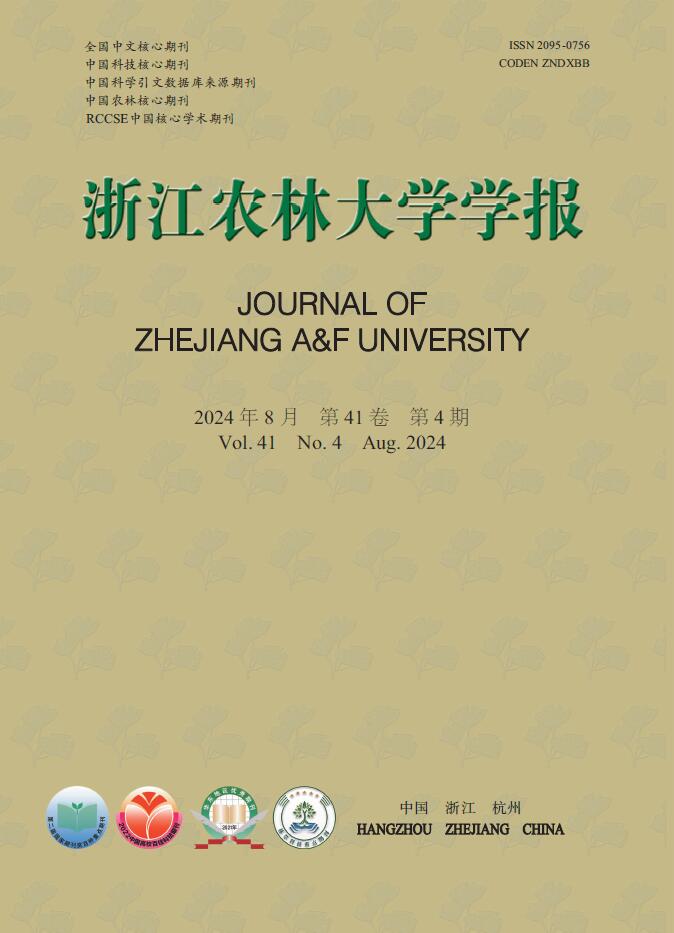







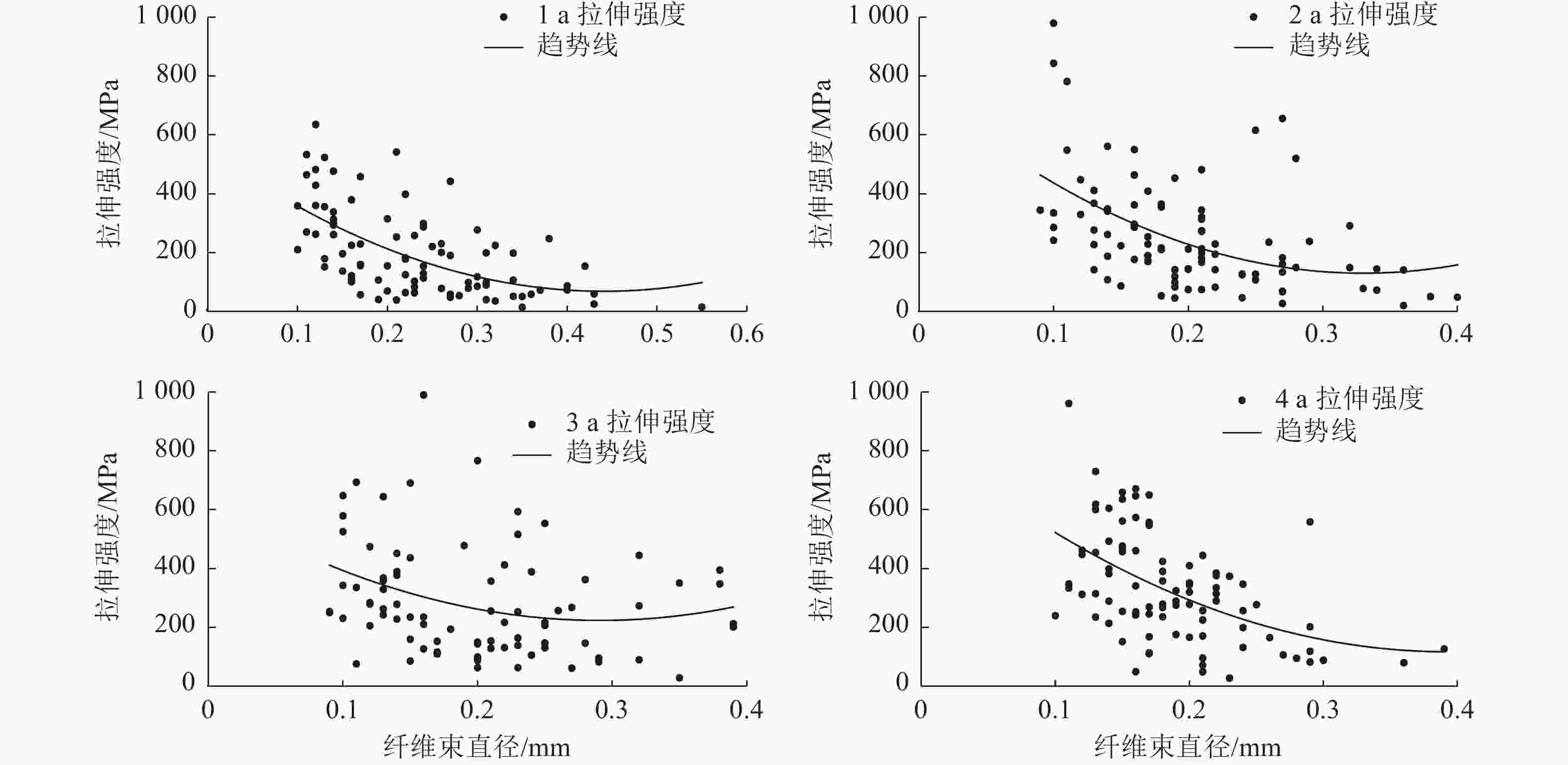
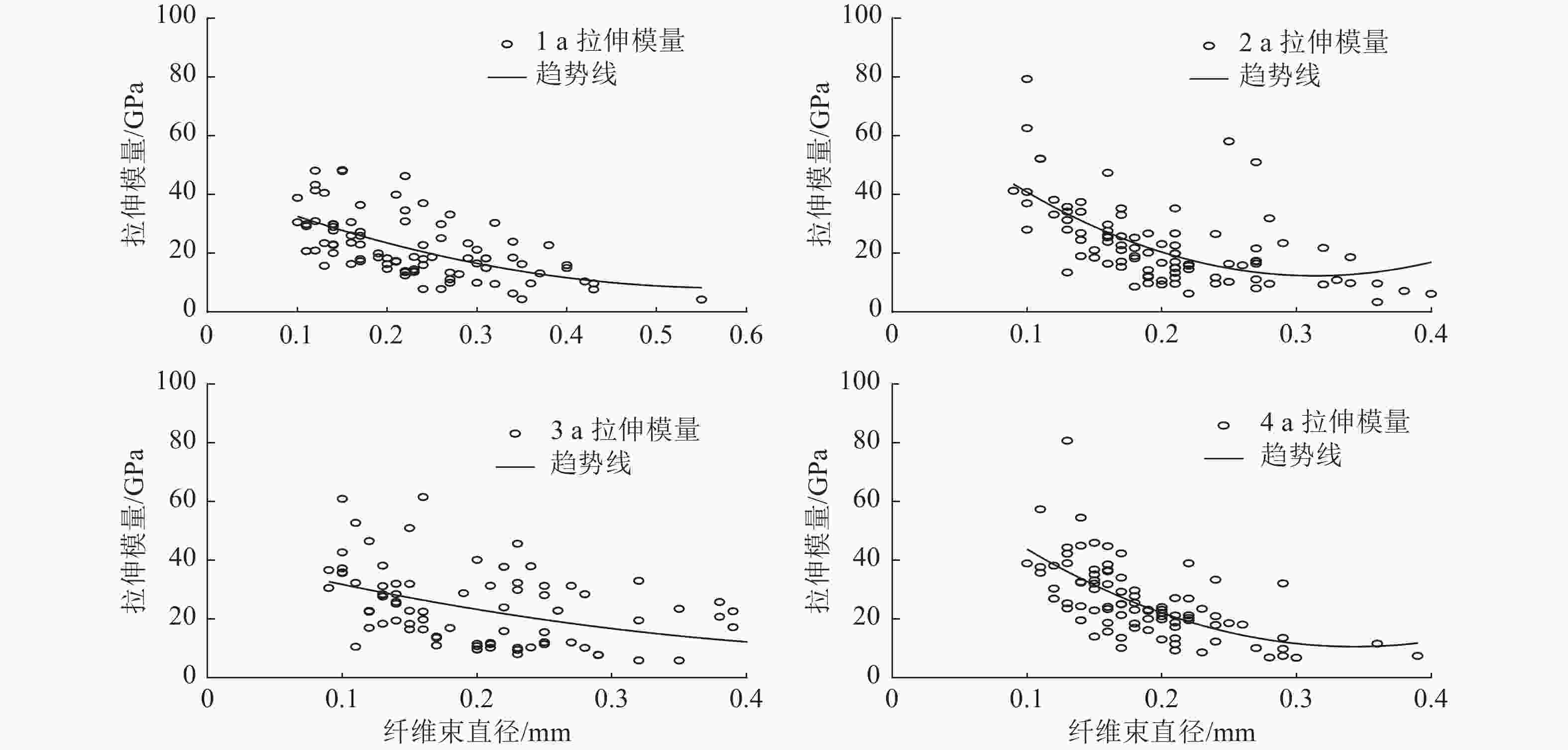
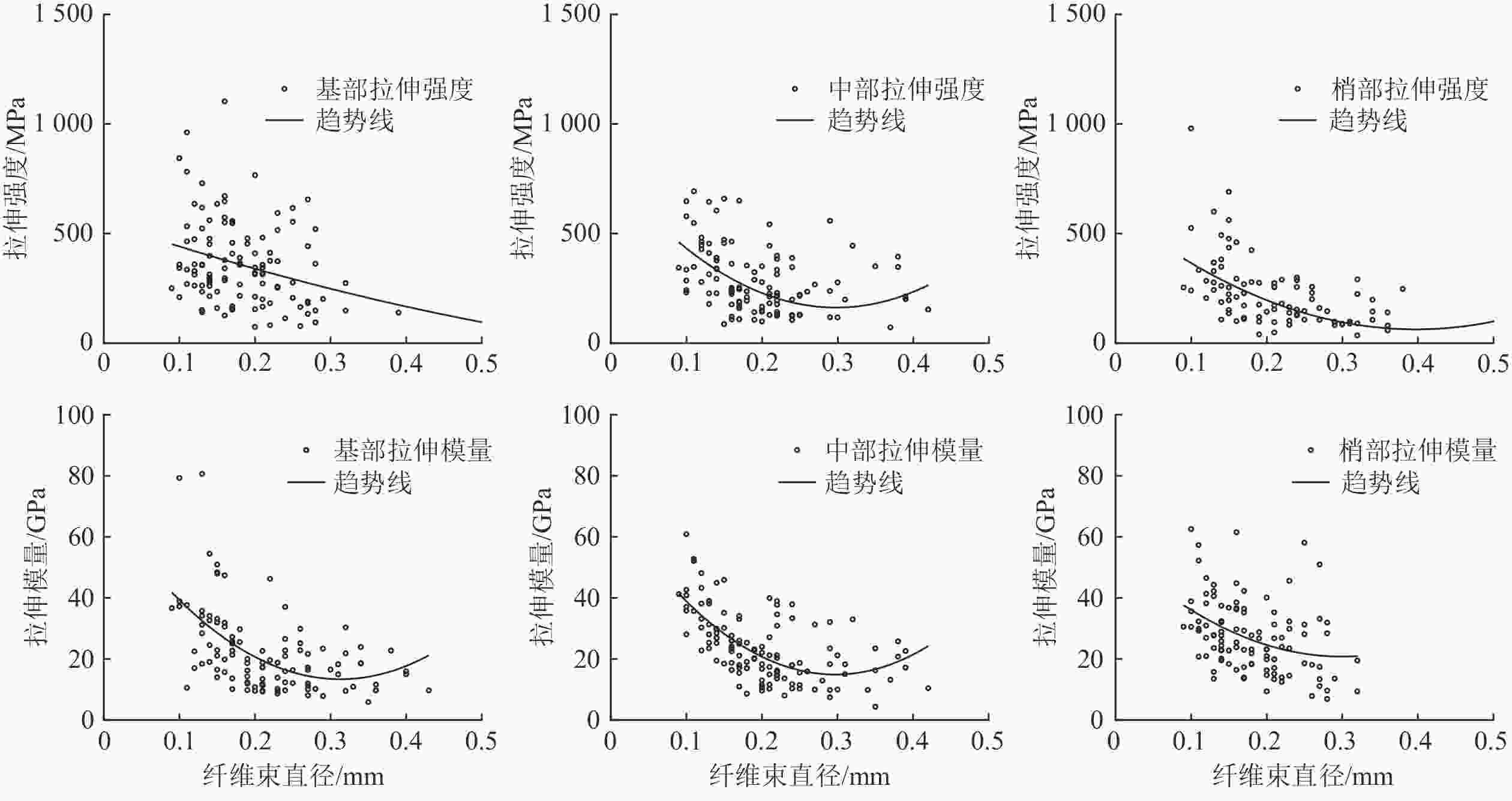
 DownLoad:
DownLoad:

